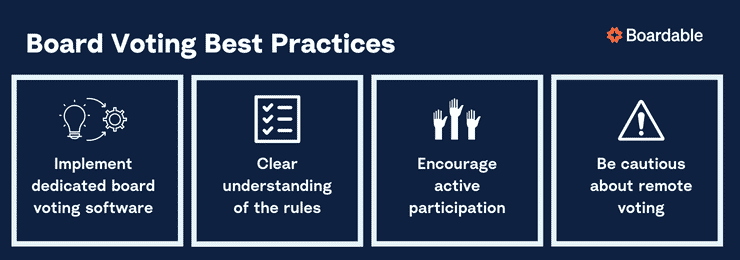We’ve all heard the cliché of boards of directors sitting around a table saying “yea” or “nay,” but the reality of board voting is much more complex than that.
From fundraising strategies to program developments, the decisions that a board makes have major impacts on its organization’s future. This group is responsible for establishing the organization’s strategic direction and creating policies that will fulfill its vision. Typically, those decisions are made through a democratic process determined by majority rule. With so much riding on these decisions, board voting procedures and practices need to be foolproof.
Everyone—especially your board leadership—needs crystal clear directions on what proposals they’re voting on and what procedures they should follow to ensure their voices are heard. Motions need to be worded carefully so that nothing can be misconstrued, and board votes need to be cast in an orderly fashion to maximize efficiency.
At Boardable, we’ve worked with thousands of professionals to deliver an exceptional board member experience. We’ve witnessed a wide variety of board voting procedures, and we have a solid understanding of what an effective process looks like for a wide range of organizations. Using this knowledge, we’ve created this guide to help your board improve its voting procedures, have more productive conversations, and arrive at decisions much quicker. Here’s what we’ll cover:
- The Importance of Board Voting
- Basic Nonprofit Board Voting Procedures
- Best Practices for More Productive Board Voting
- Board Voting Q&A
The Importance of Board Voting
Board voting is a core responsibility of any organization. There’s no room for error or unethical practices, especially when the entire organization’s success is on the line. Let’s dive into what effective board voting looks like, so your team can become more knowledgeable on the right procedures and increase its impact.
But wait! There’s one more thing before we get started. Effective voting is just one piece of the governance puzzle. Before diving into this guide, grab your free governance guide, created by Boardable’s expert board leaders. You’ll gain exclusive tips for improving activities like voting, strengthening role descriptions, and maximizing document efficiency. Download your copy, then come back to this guide to flesh out your board voting processes further.

Basic Board Voting Procedures
Now that you understand the basics, you’re probably asking yourself, “How do board votes work?”
While board voting procedures vary between organizations, all follow the same structural foundation. Regardless of your board’s exact voting procedures, your organization should structure board meetings to help maintain order in the boardroom and arrive at decisions in a timely manner.
Let’s walk through the general protocol step-by-step so you can visualize how board voting will look for your own organization. Here’s the typical rundown that most organizations follow:
Board Voting Step 1) A motion is made.
To put a motion on the floor, a board director must offer a statement that proposes action. For example, they might say, “I move to approve the proposed budget for the organization’s annual gala.”
Once a board member makes a motion, another member must second it before the board can move forward. When seconding a motion, a board director isn’t necessarily saying they agree with the motion; they’re merely stating that they agree that the topic is worthy of discussion. If it’s not seconded, the motion dies.
Board Voting Step 2) The board chair opens the floor for discussion.
As soon as the motion is seconded, board members will be permitted to talk about the proposition. They’ll have the chance to ask questions, consider all sides, and offer their perspectives.
To keep the discussion orderly, board directors must request permission to have the floor to speak, and they must address their comments to the chair to avoid creating a hostile environment.
Board Voting Step 3) Amendments are proposed.
When a more complex motion is made, there’s potential for ambiguity. Board directors should word these types of motions carefully and concisely. Otherwise, it may be unclear to board members what they’re voting on.
When a discussion takes place, a board member may move to amend the motion for clarity. If the wording of the original motion is completely clear, you can skip this step altogether.
Board Voting Step 4) The chair determines if the motion will be voted on, amended, or withdrawn.
After the conversation dies down, the chair will close discussion. If they want to move forward, they’ll call for a vote. Each board member will vote one of three ways:
-
Yea. The board member is comfortable moving forward with the proposed motion or the amended version.
-
Nay. The board member does not agree that the proposed motion is the best course of action for the organization.
-
Abstain. Abstentions are when an attendee does not vote for or against the motion, but they’re counted as ‘yes’ in board voting. Board members might abstain from voting if they have a conflicting interest in the result of the vote, for example.
Determine what method your board will use to vote in advance, whether that’s via paper ballots, board management system, roll call, or some other means. For more sensitive topics like board leadership elections, you may want to vote anonymously via your board portal. After the vote, the board secretary should record the results in the minutes.
Takeaway: Board voting may seem intimidating at first glance, but after a few rounds of practice, the process will become smoother and more efficient. Be sure to lay down your organization’s specific procedures beforehand, so everyone will be on the same page. Then, the conversation can focus on insightful discussion rather than navigating confusion. We’ll discuss a few simple ways to accomplish this below.

Best Practices for More Productive Board Voting
Once you have a general idea of what your board voting procedures will look like, you can jump into refining the process. From implementing the right software to encouraging members to speak up, there are many easy steps you can take. Let’s take a closer look at some of your options!

1) Use software to improve the board voting experience.
Today’s society is powered by technology, and that extends to board service. The right organizational software can streamline many of your organization’s daily tasks, including board voting. If your board meets virtually, digital voting is crucial for maintaining momentum and making quick decisions, especially in emergency situations when your organization needs input the most.
The board experts here at Boardable have optimized the platform’s virtual voting tools to help board members stay active and contribute to their organizations. When you invest in powerful board software, you’ll be able to:
-
Access helpful features that let you create polls either in advance or when motions are made during a meeting.
-
Enable anonymous voting for more sensitive issues so that everyone feels comfortable sharing their honest views.
-
Empower everyone to view upcoming and past polls in a convenient dashboard. That way, they can come prepared with insightful discussion points or quickly reference past decisions.

Regardless of whether you’re running virtual or in-person meetings (or a mix of the two!), these tools are immensely helpful for both your in-person and remote attendees. Whether someone’s out of town for work or unable to attend due to a family matter, they’ll still be able to actively participate.
2) Make sure everyone understands the rules.
When implementing new board meeting procedures, make sure your team is caught up on the most recent regulations. Also, bring your new board members up to speed as part of their training before their first official meeting. That way, everyone can jump in and participate.
In addition to the steps your board members create, there are organizational and local regulations you should be sure to follow as well. Here are two primary resources you should check to move forward with voting responsibly:
- Your Organization’s Bylaws: To outline your board voting procedures, start with your bylaws. What do they say about voting? Do your bylaws outline what constitutes a quorum? Who can vote? How can your members vote? Understanding your bylaws will help you understand the basic guidelines and legal parameters for board voting.
- Local Regulations: All board members should familiarize themselves with the requirements of the state in which the organization operates. With the popularity of electronic voting, ensure everyone understands these regulations in-depth to operate within state standards.
If you are operating remotely, you should review these rules in even more depth. With both of these resources, not only should you double-check how members can vote (e.g. via email, phone, board portal, etc.), but you should also make sure they’re able to vote remotely in the first place. If they are, are there any additional considerations you should keep in mind? Going the extra mile to exercise effective governance will prove invaluable in your board’s decision-making.
3) Encourage everyone to actively participate in discussions.
In most cases, your board members volunteer to serve your organization, not to sit back in board meetings and let a select few dominate the discussion. Each member resides in a position of power because they bring valuable insights to the table. Encourage them to exercise their skills by actively participating in discussions before voting on important decisions.
Created by Boardable’s experienced board management specialists, our guide to board engagement warns against lack of participation:
“When your team brainstorms ways to maximize organizational impact…poor participation levels can decrease productivity and negatively influence other attendees’ enthusiasm.”
Active participation will boost engagement and ensure all voices are heard. That way, everyone will ultimately have a say in every matter, making it less likely that someone will openly contest the end results.
RELATED: If participation has fallen by the wayside while operating remotely, take a look at our guide to virtual board meetings. You’ll learn how to maintain momentum and reignite board members’ passion in your meetings.
4) Be cautious about how board members vote on important issues.
While remote voting is certainly beneficial, your board leadership should exercise caution when deciding on important issues, like electing new board leadership or hiring a nonprofit executive director.
Everyone should participate in the discussion to hear all sides of the matter in these cases. Before the situation ever occurs, be sure to think through these questions for when a board member can’t participate and hear all sides:
- Should they be required to vote on the measure later?
- Do they forfeit their vote?
- Where do you draw the line on being present at a board meeting as a requirement to vote on motions?
If a board allows remote voting, there should be specific guidelines about when it is permissible. The bottom line is that your board should be cautious about how board members vote so that the organization stays on the right path moving forward.

Wrapping Up The Discussion on Board Voting
With your organization’s success relying on the board’s decisions, effective board voting procedures are not something your team should gloss over. Your organization and all stakeholders who support your initiatives deserve the assurance that voting is effective and transparent.
Effective board voting starts with a sound structure and is refined through plenty of practice. Remember, dedicated software like Boardable’s Polls + Virtual Voting feature can streamline the board voting process, so your team will spend less time navigating meeting procedures and more time making impactful decisions.
Now that you understand the nuances of board voting, you can move forward with confidence! If you’re looking to learn more about effective board management, check out these great resources to develop active and motivated board directors:
-
How to Run a Board Meeting that’s Engaging and Productive. Make sure your meetings are highly productive, so your team can have enough time to discuss important matters that require an official board vote.
Board Member Recruitment: How to Build a High-Impact Board. Struggling to find the right board members to put your organization on the right path? Check out our complete guide to board recruitment, so you can start building your board with the best foundation possible.
Do you offer a free trial?
Absolutely! We encourage you and your team to try before you buy. You can start with a free trial of our Professional plan features for 14 days to help decide what’s best for your organization.




